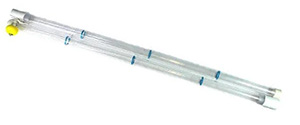Indiana Septic System Installation and Permit Procedure Guide
To learn about my inspection services, see my Septic Inspection Page
The five steps to installing a new septic system in Indiana:
- Step One – The On-site Evaluation:
- Step Two – System Requirements:
- Step Three- Design:
- Step Four – Permitting and System Bids:
- Step Five -Septic System Installation and Inspection:
Step One – The On-site Evaluation:
Most county health departments in Indiana require a soil investigation by a soil scientist. Soil scientists conduct a careful evaluation of your soils to a depth of 5-6 feet using a hand auger. S/he will pay special attention to the soil texture, structure and evidence of a seasonal high water table, poor filter or compact till. These soil properties are then used by your local health department to determine minimum requirements, per local and state septic regulations.
Tip: Some soil scientist really love soil (and like to talk about it). If this subject interests you, be sure to join them in your backyard. If not, you may want to stay inside.
Step Two – System Requirements:
Each County Health Department in Indiana is responsible for issuing requirements for residential septic systems. These health department employees, sometimes referred to as sanitarians or environmentalists, will issue minimum septic system requirements after reviewing the soil scientists reports. Be aware that some counties also conduct their own soil borings! So, be sure to check with your county before you go hiring a soil person willy-nilly. I’ve listed some Indiana County Health Department contact information HERE. A list of Indiana Soil Scientists can be found HERE.
The septic system requirements that you receive from you county sanitarian will include information such as:
- System Type
- System Size
- Trench Depth
- Perimeter Drain Requirements
- Septic Tank Size
- Dosing Tank Size
Step Three- Design: The next step in your septic system adventure is a system design. I have helped thousands of homeowners, excavators and builders through the septic system process with my comprehensive designs. The design is the most important part of the entire septic process! Benefits of an accurate, detailed and well planned design are significant:
- Wise design choices can save you money
- Simplifies the permitting and bidding process
- Excavators all bid off the same plan
- The system is marked on-site making installation easier for the excavator
- The design identifies all system components. This keeps a dishonest excavator from “cutting corners” by using substandard materials
- All system elevations and bench mark are included ensuring a smooth install.
- With new construction, the builder, poured wall contractor and excavator are all working off the same plan. This helps to eliminate expensive mistakes!
- Proper sizing of the effluent/sewage pump ensures the pump is operating within its design parameters (meaning they will last much longer).
- You, the homeowner, owns the design and the permit
- The Health Department requires a design and must approve it before a permit is issued.
Visit my services page or commercial design page for more information. Step Four – Permitting and System Bids Once the Health Department has approved the design and application, they will issue the septic permit. Counties have different policy’s about when the application should be submitted. Some applications are submitted with the soil boring report from the soil scientists while some are submitted with the design. Again, check with your county to find out what their specific policy is. Now that the permit has been issued based on the submitted design, it’s time to get quotes on system’s installation. I’ll provide you with multiple copies of the design (to share with others) and, upon request, I’ll solicit bids for you by sending the design to three excavators of your choice at no extra charge. All you need to do is sit back and wait for friendly excavators contact you with pricing. Be sure to work out a detailed contact agreement with your excavator! The following are some questions that a contract should clarify:
- How long is the contract valid for?
- What date the work will begin?
- What date the project will be completed by
- When payment is due?
- Who is responsible to fix the sprinkler system if it is damaged?
- Who is responsible for final grading and seeding once work is done?
- How might the weather effect the installation schedule?
- Will I be able to run water and flush the toilet while the system is being installed?
- If the new system requires a pump, who is paying for the associated electrical work?
Step Five -Septic System Installation and Inspection: Hurray, the day of installation has finally arrived! The excavator has installed your system and now is awaiting inspection by the health department before he backfills. Your yard is now a much bigger mess than you ever could have imagined. Seriously, it will appear that an entire war was fought in the confines of your yard. Try to be mentally prepared for this. Yoga helps!
Next, the septic inspection is conducted by your friendly county health department sanitarian. The following is a long list of things the inspector will be… well, inspecting:
General:
- Were soil borings conducted in the area of the installed system?
- Are there any wells within 50′ of the system?
Gravity sewer between the house and the septic tank:
- Minimum fall of 4″ in 25′ and maximum slope of 36″ in 24′ (in a 4″ diameter pipe)
- Is the schedule (specifications) of the pipe acceptable?
- Are pipe joints primed and glued properly?
Septic Tank:
- Is the septic tank at least 10′ from the house?
- Does the tank have necessary inlet and outlet baffles?
- Is the tank the proper size?
- Does the tank have a riser to the ground surface?
- Was the tank set level?
- Are the inlet and outlet pipes connected to the tank in a waterproof fashion?
- Is there a water tight seal between the tank and riser?
- Does the tank appear to be water tight?
Effluent Sewer:
- Is the effluent sewer of an acceptable specification?
- Does is have good connections to the septic tank and distribution box?
- Are pipe joints primed and glued properly?
Distribution Box:
- Is the D-box setting level?
- Does the D-box inlet have a tee or elbow installed to baffle the inlet flow?
- Does the D-box seem stable (on solid ground)?
- Are there unwanted critters setting up house in there?
Trench Header Pipes:
- Are the pipes of an acceptable specification?
- Are the pipes level or have slope to the trench laterals?
Trenches:
- Are all trench bottoms level throughout their length?
- Is the stone the correct size (.5″ – 2.5″) and clean?
- Is the perforated lateral pipe the correct specification?
- Is there 6″ of stone under the pipe and 2″ over the pipe?
- Is there geo-textile fabric over the stone to keep the soil out?
Dosing Tank (i.e. pump tank):
- Is the tank the correct size?
- Was the tank set level?
- Is the correct pump installed (according to the approved desgin)
- Are the electrical connections made in a gas tight fashion?
- Are the on/off floats set correctly?
- Is there an audible and visual alarm?
- Are the inlet and outlets connections water tight?
- Is there a riser to the ground surface large enough to service the pump through?
- Is there a check valve and weep hole?
- Is the force main of an appropriate specification?
- Is there a water tight seal between the tank and riser?
- Is there a double lid?
- Does the force main have slope to drain back to the dosing tank between doses?
Perimeter Drain:
- Is the drain deep enough?
- Does it have the proper minimum slope of .2′.100′ to the point of outlet
- Does the drain surround the system or is it only on the uplsope side?
- Was the drain trench backfilled with proper material and to a proper depth?
- Does the pipe in the bottom of the trench improperly rise and fall in the trench?
- If the tile outlets to another tile, is that tile free flowing?
- If the tile outlets to a ditch, does it outlet above a normal high water mark in that ditch?
- If the tile outlets to the roadside ditch, was permission to do so granted by the County Highway Department?
- If the tile outlets to a county regulated drain or ditch, was permission to connect granted by the County Surveyor’s Office?
Mound System Inspection:
- Does the soil exceed the wetness threshold (plasitc limit) for plowing?
- Is the mound on contour?
- Does the force main have slope to drain back to the dosing tank between doses?
- Is the plow layer adequate?
- Furrows turned up slope?
- Is the sand highway specification 23 (as required by code)?
- Was the sand applied in a way that avoided compaction?
- Is the gravel washed and clean (.5″ – 2.5″ dia.)
- Are the force main, laterals and manifold of an allowed specification?
- Will there be a squirt test to be sure the pump is sized correctly?
- Was geo-textile fabric applied to the top of the gravel bed?
- Was the final cover adequate (6″ of clayey textured soil topped with 6″ of loamy textured soil)?
- Does the mound maintain a maximum slope of 3:1?
- Was the mound seeded and protected from erosion?
Once the system is inspected and approved, the health department representative will issue some sort of approval ticket and go to lunch. If there are any violations, the county sanitarian will leave a note detailing what needs to be remedied. If not approved, the health department sanitarian will need to return for a follow-up inspection.
With approval note (sometimes called a green tag) in hand, your excavator will cover up the system and promptly ask you for any money you still owe him. Once paid in full, he will surely return your missing son Jimmy completely unharmed.
About Meade Septic Design Inc. Services
View Meade Septic Design, Inc. Commercial Clients and Projects
Got septic system questions? Contact me!

